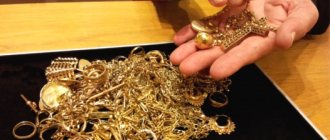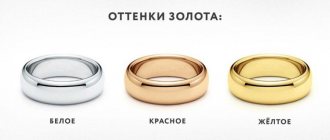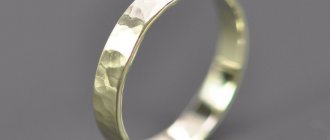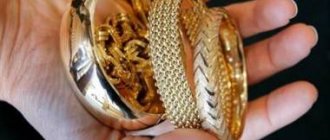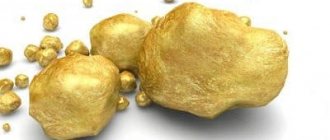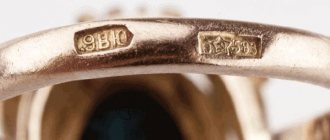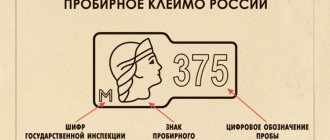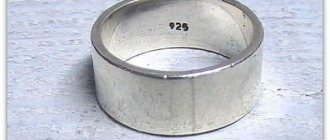In the last two decades, when the jewelry market has been flooded with low-quality products, an increasing number of citizens are seeking to purchase, if not new, products that comply with established standards. The 583 standard of gold causes bewilderment among some ordinary people, while among others it causes approval and the desire to make a successful and profitable purchase. And the whole point is that today 583 is a high-quality standard of jewelry made during the years of the Soviet Union and, as they say, conscientiously.
Almost every family still has jewelry from that time, and it is now passed on from generation to generation. If such products are put up for sale in a pawnshop, they are quickly taken apart by nostalgic citizens not only of our country, but also of other related states. What is so special about Soviet gold and why is it so valued today?
Sample 583 as an echo from the USSR, the history of its appearance, its features and composition
From the very beginning of its existence, the USSR adhered to its own policy. The country strived for independence and isolation from the rest of the world, which was evident even when creating jewelry.
Gold jewelry.
Jewelry works of the USSR The whole world used the carat system to determine precious alloys. The USSR followed its own path, introducing the metric measurement system.
Throughout the world, pure gold was equivalent to 24 carats. The value of the alloy used to create jewelry was equal to the number 14 in the carat system. In the USSR, 14 was divided by 24, and the result was multiplied by 1000. The resulting non-integer result was rounded, resulting in the number 583.
This is how a real Soviet-era brand was formed - 583 alloy. The percentage of pure material from the total mass of precious metals was 58, but sometimes a slight plus error was observed. 33% was copper, the remaining 8% was silver.
Soviet jewelry art versus modern jewelry: which is better?
Disputes among jewelry lovers about which gold standard is better, 583 or 585, continue to this day. Nostalgic citizens not only of our country, but also of neighboring countries, longingly remember the times when gold jewelry could be easily purchased without worrying about its quality. With the collapse of the Soviet Union, the standard for gold jewelry disappeared, giving way to the 585 standard accepted throughout the world.
Differences in GOST standards and quality
The models were produced according to established standards. This meant exact compliance with GOST standards in terms of composition percentage, melting characteristics and product durability. Jewelry with 583 hallmarks had massive dimensions, strength of composition and high performance properties.
Turkish gold and the introduction of GOST standards for testing
In the 80-90s, imported 585 standard began to appear on Soviet shelves. It was massively imported into the country from Turkey. Citizens of the USSR immediately began to buy the wonder; yellow Turkish gold was very different from red Soviet gold.
The jewelry from Turkey was of disgusting quality; the composition contained gold foil. The jewelry became deformed, turned black, and broke.
What was happening caused a wave of indignation on the part of Soviet citizens. The Turkish 585 marking disappeared from the stores, and in its place the display cases were again filled with 583 gold of the highest category.
They stopped producing this alloy only in 1995, when the country had to adopt new GOST standards.
Reasons for mistrust
During the 90s, Turkish-made jewelry gained dominance on the Russian gold market. All of them were marked with the hallmark 585, but most of them were made of very low quality alloys, unable to withstand not only external influences, but also long-term wear.
During the time of the USSR, jewelry lovers became fed up with gold of the traditional reddish hue, so they began to buy rings and chains made of yellow and white metals with great pleasure. However, having received low-quality goods from Turkish jewelers, Russians for many years acquired distrust not only of the 585 marking, but also, in general, of high-quality yellow and white alloys.
The situation changed after the introduction in 2000 of a ban on the import of low-grade foreign-made gold into Russia. Today, domestic jewelers offer customers only the highest quality products made from yellow, red and white alloys of various grades. All decorations are made from materials that comply with state standards approved in the country.
True, manufacturers have the right to independently determine the composition of the master alloy, that is, the qualitative and quantitative composition of impurities. The color of the metal may depend on this, but its fineness will remain unchanged.
Gold for export. Reasons for switching to 585 sample
The USSR collapsed, the Iron Curtain collapsed completely, and it became necessary for the country to enter the European market.
The world refused to accept the “USSR brand” as an equal. A snag arose - when converted to the carat valuation system, the value of the 583 sample was 13.9 carats, instead of the proper 14. For Soviet products, they offered a lower price than for similar ones, but corresponding to world standards.
There was a need to introduce a new standard, the country switched to the well-known alloy 585.
The famous Soviet standard - 583 gold
Areas of use
The main value and applicability of gold is in its international monetary equivalent. Soviet gold and 583-karat alloys have a pronounced reflectivity; they are ideal conductors of thermal and electrical energy. The metal is highly polished with a high degree of ductility. It is used to make contacts and fuses for important electronic devices. The main consumer of gold is the electrical industry, which uses several hundred tons of material annually.
Gold plates cover the mirrors of electronic telescopes used to study galaxies, the domes of Orthodox churches, and the frames of icons. It is used to produce particularly precise instruments for medicine. Colloidal gold is added during glass production. Gold and alloys are widely used for gilding surfaces and dentures.
The most popular products made of 583 gold among the people are gold jewelry. This category includes: chains, pendants, earrings, brooches, rings, rings, tiaras, bracelets, watches, cigarette cases, cigarette holders, pince-nez, glasses, cufflinks, hairpins. Jewelers often make to special orders: pens, elements for canes, figurines, smoking pipes, writing instruments.
The main differences between samples 583 and 585
Many people believe that when switching to a global model, the “advice brand” only changed the numbers in the name of the sample, but in fact there is a difference.
It is these differences that contribute to the fact that buyers give preference to one or another alloy.
The ratio of precious metal and impurities
The first difference is the gold content. The 583 sample contains 0.2-0.4% less of this noble metal than the generally accepted 585 sample. The discrepancy may be quite insignificant, but it exists. The remaining 33.5% is allocated to copper, 8% to silver, there is no difference here.
Precious metals and impurities
Gold tone
The 583 alloy is more characterized by a red tint. The precious metal was used for minting coins, so the resulting money was often called “chervonets”.
Works with a mark of 585 are often yellow.
But deviations are normal for both alloys, with shades of 14 different colors found.
Type of mark
Initially, mark 583 depicted, in addition to numbers, a male profile and a hammer. Later, the print was changed, and an image of a star, sickle and hammer appeared, which were firmly associated with the USSR.
The modern hallmark for 585 gold looks like an imprint of a woman looking to the left.
Soviet gold - ring with stone
Alloy purity errors
Although both precious metals are equal to 14 karats, each is subject to slight individual uncertainty regarding the presence of pure gold. For 583 alloys, an error of 3% in both directions is considered normal. For 585, the deviation from the purity volume norm can only be in the positive direction - up to 5%.
Chemical composition
The numerical indicator of the hallmark indicates the actual content of precious metal in the alloy from which jewelry is made. This is the main factor that determines the price per gram of the finished product for any sample. But since it is very difficult to achieve an absolutely exact amount of precious metal in the alloy, a permissible deviation (remedium) from the normal value of +3/-3 was accepted.
In the country of the Soviets, the main values of a product have always been reliability and quality. Therefore, the composition of the ligature (additive to gold) was selected in such a way that the jewelry would be quite hard, less susceptible to deformation and capable of maintaining its original appearance for a long time.
The color of the alloy depends on the percentage of metals in the alloy mass, according to which 583 gold can have the following composition:
| Color | Density (g/cm3) | Gold alloy composition (%) | ||
| Gold | Silver | Copper | ||
| Yellow | 13,24 | 58,3 +/-0,3 | 8 +/-0,5 | 33,7 |
| Green | 13,92 | 58,3 +/-0,3 | 30 +/-0,5 | 11,7 |
| Red/pink | 13,01 | 58,3 +/-0,3 | — | 41,7 |
It is the metals (in their pure form, without impurities) of the alloy mass that give the alloy the specified properties. Without a ligature, the products will be fragile, since gold itself is quite soft, not very suitable for making jewelry.
Where can you find 583 gold?
Works using such an alloy are a real rarity in the showcases of modern jewelry outlets. You should try your luck with the search in private workshops, antique shops, pawn shops, and online auctions.
Sometimes such products are found at thematic exhibitions dedicated to the life of Soviet people.
Buying jewelry at a pawnshop
Tips for choosing gold jewelry
Jewelry is an expensive and durable product, so you should approach your choice wisely: choose and purchase jewelry in specialized stores and famous jewelry houses. When buying from a private person, be sure to use the services of an expert. Do not make purchases based on photos or from dubious individuals.
Sources
- https://zolotoe-runo-sl.ru/proba/583-zolota.html
- https://zhazhdazolota.ru/proby/583
- https://TokyoStreet.ru/dragocennye-kamni/zoloto-sssr-583.html
- https://GoldMiddle.ru/vse-ukrasheniya/sostav-583-proby-zolota.html
- https://zaimzoloto.ru/articles/583-proba-zolota/
- https://art-posh.ru/ukrasheniya/zoloto-583-i-585-proby-otlichiya.html
- https://ToZoloto.ru/proba/kakaya-proba-zolota-luchshe-585-ili-583.html
- https://vplate.ru/zoloto/583-proba-i-585/
- https://golden-inform.ru/proby/sovetskoe-zoloto-583-cena/
- https://ProDragmetally.ru/o-zolote/proby/sostav-i-osobennosti-583.html
- https://ZolotoBlog.ru/zoloto-583-proby.html
- https://lombardyinfo.ru/stati/cena-583-proby-zolota.html
Soviet gold - the standard of quality: myth or truth
Everyone knows that the USSR placed emphasis on quality and long-term service in production. Numerous reviews of products from those times confirm this rule. Jewelry created from the Soviet 583 alloy was truly distinguished by its resistance to various types of damage, reliability, and wear resistance.
Many people still have earrings, rings, and bracelets from those times at home. You can see that the years have not affected the appearance of the products. They will look like new if they are cleaned of natural deposits.
All products of the USSR were produced in compliance with GOST and the strictest technological rules. Low quality was considered unacceptable.
Gold ring with the hallmark 750
The party never spared precious metals for production. This is especially noticeable when you compare standard wedding rings from that era to those of today.
A ring made by craftsmen from the USSR era will be much thicker and heavier.
It is worth agreeing that the characteristics of 583 samples were somehow superior to modern analogues. Under the USSR, this alloy had a reputation as the most reliable, but it still cannot be called a standard of quality.
Properties
In the industrial production of the 583 alloy, a three-component composition with high strength, ductility and ease of use was used, including 33.5% copper and 8% silver. It was the high copper content that gave the metal a noble color with a distinct red tint - such gold was called red gold by analogy with the royal chervonets, which were minted from an alloy of gold and copper and had a similar color.
Strength
Using chemically pure precious metal to make jewelry is impractical, as it is too soft a material. Any thing made of 999 gold will very quickly lose its attractiveness and shine.
In the form of an alloy, gold has much greater strength and resistance to deformation and wear. With proper care, such a piece of jewelry can be passed down from generation to generation as a family heirloom without losing its presentability.
Caring for 583 and 585 gold
Gold alloys tend to darken due to impurities in their composition. Contact with human skin, different temperatures, and other negative external factors also contributes to changes in appearance.
The best way to care for any precious item is to periodically visit a jewelry workshop. Our experts can clean and polish your jewelry, giving it a shiny new shine.
You can care for gold at home in the following ways:
- You need to place the decoration in a mug containing a soap solution and 4 drops of ammonia for 25-30 minutes. Next, the product will need to be rinsed with running water and wiped dry.
- A similar method, but in a container you will need to mix water with 2 tablespoons of salt. The decoration can be left for half a day.
- For the third method, you will need ceramic dishes, food foil and soda. Cover the bottom of the container with foil, dissolve 2 tablespoons of soda in a mug of water, and pour the liquid into the container. Place the product in the resulting mixture, leave for half a day, and then wipe dry.
Important! Avoid contact of 583 and 585 gold with alkaline reagents. Be sure to remove rings before cleaning or use rubber gloves. Household chemicals often contain aggressive substances.
How to choose jewelry in a store
It is recommended to purchase a product of any standard in jewelry stores. They often sell low-quality alloys with a thin gold coating that will wash off in a month.
Before purchasing, examine the surface and ask for a certificate. You can return your purchase to the store if there is a flaw that the seller missed.
The higher the sample, the lower the strength. It is recommended to store jewelry not for every day in fabric bags or boxes with soft walls. Products with different samples are stored separately so that they do not come into contact.
To summarize: 583 is popular among nostalgia lovers. It is lower than its modern analogue - 585. Externally, the products look more massive and do not shine much. Due to the high content of precious metal (58.3%), they are wear-resistant and durable.
In some cases, the surface may change color. It is recommended to clean with a soapy solution and ammonia.
It is recommended to purchase jewelry from trusted jewelry stores. Before purchasing, check the surface, stamp and certificate.
Differences in GOST standards and quality
And yet there is a difference between the 585th and 583rd samples. It lies in the difference in requirements for one and another alloy. For the latter, the deviation in the precious metal content in the total mass can be 3 units, both upward and downward, that is, the alloy can be either 580th or 586th fine. In 585, a deviation of 5 units is allowed, but the remedium (deviation, tolerance) can only be positive. Thus, jewelry with a pure gold content of 59% has the right to exist, but with 58% it is considered defective. And yet, the deviations from the norm are so small (the largest difference between gold of both samples cannot exceed 1%) that the debate about which gold is better loses its meaning. Maybe someone will be more pleased to know that the manufacturer put a little more precious metal in them than they should have.
It is worth adding that a negative attitude towards 58.5% gold was formed in the years when the so-called Turkish gold predominated in imported goods. In most cases, it was of disgusting quality, from which nothing good could be expected. Crafts from Turkey clearly did not live up to the stated standard. At the same time, consumers could compare imported products with the contents of boxes purchased during the Soviet years. It was possible to tell by touch the difference between a Turkish craft and a piece of jewelry made at one of the Soviet jewelry factories.
Visually you can't tell the difference
Today, the question of bad gold can be removed, since stores offer a wide range of high-quality products of almost any standard, and even the most demanding jewelry lover can choose them to suit their taste.
Standards for marking the Russian hallmark on products
Jewelry of 583 samples contained on its surface:
- A numerical value indicating the content of pure noble metal in the composition;
- To the left of the sample there was a picture embossed in relief with a worker’s head and a hammer. This mark was relevant until 1958, during which time it was replaced by the image of a five-pointed star with the symbols of the USSR. During the years of perestroika and adjustment of products to European standards, the 583 hallmark was abolished and instead they began to use the 585 hallmark, which exactly corresponds to the 14 carats of the Western hallmark.
583-karat chain
However, the Soviet mark did not go away and did not sink into oblivion: after all, the population had and still has a lot of jewelry and expensive crafts made of gold of this marking. Therefore, metal with such a numerical value on the surface is bought, sold and accepted for processing even today.
It would be useful to note that the old mark was affixed to products right up to the spring of 2000, so you can see jewelry released after the collapse of the USSR with nostalgic markings on the surface.
Fake gold standard
Not every swindler will decide to counterfeit a gold sample, since it is difficult and involves huge risks. Typically, fraud involves putting a high standard on a low-quality product that still contains gold. Similar products can be bought in small shops around the world, but by chance they can also be sold in decent jewelry stores. A well-made counterfeit sample is almost impossible to detect by eye, which is why it is necessary to check the alloy itself.
A portable device that can help with this is a gold detector that you can carry with you while shopping. It is worth remembering that the device may have its limitations and errors, so you should not trust it completely.
